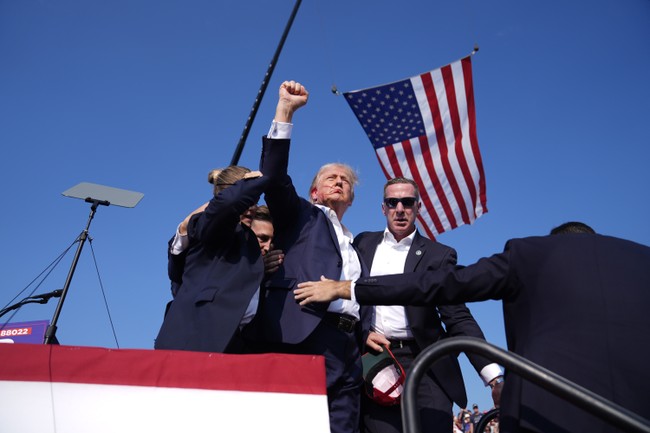WSJ: Suddenly, It’s Hip To Be MAGA
This post was originally published on this site

Donald Trump ran on the promise to Make America Great Again, both in 2016 and 2024. He won a narrow Electoral College victory the first time while trailing in the popular vote, and lost both in 2020. This time, however, Trump won both, impressively and decisively.
Advertisement
Did Trump win because he made conservatism great again, or is it the other way around? The Wall Street Journal reports that it’s suddenly hip to be MAGA, to paraphrase Huey Lewis & The News:
Across many facets of society—in sports, entertainment, the classroom and the workplace—there are signs that MAGA isn’t just retaking the White House. It is gaining a firmer foothold in the broader culture.
Instead of taking a knee to call for social justice, NFL players are doing the “Trump dance” in the end zone at football games. Mainstream entertainers, among them the country singer Carrie Underwood and the rapper Snoop Dogg, agreed to perform at events celebrating Donald Trump’s inauguration, something music stars largely shunned eight years ago.
A new generation of Trump-friendly comedians and wellness influencers is populating YouTube and other social media, while a snippet of audio featuring Barron and Melania Trump has become one of the hottest online memes, with celebrities such as Paris Hilton and brands including Frontier Airlines using it in their TikTok and Instagram posts.
“Every time I walk on campus, I see a few MAGA hats. That’s definitely new,” said Carson Carpenter, 19, a senior at Arizona State University. Conservatism, he said, “has really become intertwined in our pop culture…. It’s really showing that conservatism is cool now.”
Advertisement
This sounds like a chicken-egg argument, but it’s possible that neither really can explain this cultural shift properly. Instead, one has to consider that the inflection point came on July 13 in Butler County, PA:
Looking back at this moment, one can clearly see this as a dividing line in the arc of the election, and possibly the culture as well. Trump’s dramatic gesture in defiance of danger — which he had no way of knowing had been neutralized — galvanized his supporters as well as the entire nation. It may be too glib to claim that Trump won the election at this moment, but it turned out to be the inflection point — both politically and culturally.
Many assumed that would be the case, and the moment was so extraordinary that it was clear it would matter politically. But that wasn’t just true of electoral considerations; Trump made his vitality and vigor clear, as well as his personal courage. That provided a stark contrast to Joe Biden’s decrepitude, which had been displayed on national TV less than three weeks earlier. Less appreciated perhaps is the contrast that it provided to Kamala Harris’ lack of courage in addressing the media or voters after Biden quit the election and Harris got anointed to replace him. Harris didn’t even offer to compete for the spot, instead refusing to put herself at risk of exposure as an empty suit.
Advertisement
Meanwhile, Trump went back to Butler County. Trump pulled a shift at McDonald’s. He drove a garbage truck, albeit briefly at the behest of his Secret Service detail. He fought. And fought. And fought.
That display of courage and brashness could not help but have a cultural impact, too, because it contrasted with the previous reluctance of Trump supporters to speak up. The Trump dance went viral; MAGA hats appeared; voters put their support out in public much more enthusiastically than ever before. And in fact, Trump became even more popular as well. As of today, Trump is now viewed more favorably than unfavorably in the RCP aggregation for the first time since riding the elevator down to the Trump Towers lobby in 2015. The latest Harvard/Harris poll puts Trump’s favorability at 51/43.
Salena Zito, one of the few reporters in America to accurately report on Trump’s impact over the last ten years, saw it happening before her eyes. The night before Election Day, Zito saw it in a Pittsburgh rally:
If you wanted to have a keen, dispassionate understanding of how much the Republican Party has changed over the past eight years, all you had to do was stand outside the PPG Paints Arena in the city’s Hill District neighborhood and see the line of people stretched 10 blocks in either direction up Fifth Avenue.
The attendees were young, male and female, and diverse. There were black, white, Hispanic, and Asian people all having a great time, getting to know each other, singing songs in line, swapping stories of where they were from, and almost always finding out they shared a mutual friend.
Inside the arena, one could witness the emergence of a new coalition of Republican voters: union workers, nurses, janitors, businessmen and women, doctors, lawyers, police officers, and college students of every race and generation.
Advertisement
What happened? A diverse coalition of American voters rejected the extremism of the ruling elite clique — as well as their propaganda about the existential danger that Trump supposedly fronted. And now that same bankrupt elite clique have spent the last ten weeks trying to suck up to Trump, providing even more evidence of their political and moral bankruptcy — while Trump keeps fighting.
Christian Toto and I will discuss this more in our Off the Beaten Path episode tomorrow.
